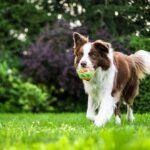We all know the basic cues that tell us if our canine companions are truly happy, whether it’s the wag of a tail or the zoomies in the room. Just by picking up the lead you’ll see all of those happy emotions pour out of your pup.
If we had the ability to speak with dogs, there are so many questions we would ask to discover what makes them happy. However, we can’t communicate together in this way, and therefore we have to learn this through body language, behaviour, and sometimes even health.
So, ‘is my dog happy?’ There are specific signs that indicate whether or not your dog is happy. So to celebrate Happy Dog Day on the 9th September, we’re diving into this topic with a big waggy tail. Read on to find out how to tell when your dog is happy, and how they express their emotions.
Dogs and Their Emotions
It’s a well known fact, that dogs have the emotional capacity of a 2 year-old child. They experience similar emotions to humans like joy, fear and anger. According to the book ‘What It’s Like To Be A Dog‘ they even experience similar chemical changes in the body that humans do during emotional shifts.
Like toddlers, dog’s use their body language and behaviour to communicate their emotions. If your pooch is sad, you might know this through whining, if they’re frustrated, you might know this through a big ‘woof’.
What Are The Physical Signs?
Every dog is different, but ultimately, happy dogs have a relaxed posture. You might find they have relaxed ears, which may even flop or a soft, partially open mouth or little blep. Their tail wag will involve whole body wiggles and during play they may ‘bow’ with their rear in the air and chest lowered. They may even roll over to show their belly, which is particularly telling if they do this while sleeping as it means they fully trust you and their environment.
What About The Behavioural Signs?
There are a couple of behavioural things dogs do which can also indicate specific emotions, but again be mindful that every dog is different and this is just a generalisation. Based on your dog and their personality, your own list may look different to the list below.
The one we all know and love is the excitement and wiggle when you walk through the door. If they’re excited to see you, it’s a great sign that they are happy and content. While it’s great to know how much you’re loved and missed, this behaviour shouldn’t be overly encouraged as it can be a contributing issue to separation anxiety.
If they have a healthy appetite, then they’re physically well and emotionally content. Changes in appetite can mean a sign that something isn’t right, including unhappiness or depression.
If your dog leans into your hand or body then this is a great sign of love and affection. Actually if you lean into them slightly it’s a way of them telling you just how much you love them too.
If you’re coming home to a trail of destruction, then this is a sign of anxiety and stress. Click here for more information on dog mental health conditions.
How Can I Make My Dog SUPER Happy?
Ultimately, dogs feed off our emotions. When we’re happy, they’re happy. When we’re stressed, while they don’t know the reason behind the stress, they feel it too. So by making sure you’re healthy and happy will in turn keep you pooch content, comfortable and happy.
Aside from that, keep doing what you’re doing by providing for their needs, emotionally, intellectually and physically. Treat them to mental stimulation through canine enrichment games. Make sure they have a healthy diet and an appropriate amount of exercise. Build on your special bond by learning how to say ‘I love you’ in dog language.
Remember, happiness is one of many emotions that your dog is capable of feeling. Stay attuned to your dog’s needs, their emotional cues, and any changes in body language or behaviour.
How Do You Know If Your Dog Is Happy?
Do they shower you with kisses? Perhaps they have a wiggly butt which makes you giggle? Let us know in the coments below.








